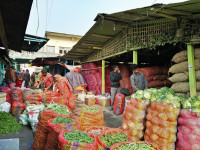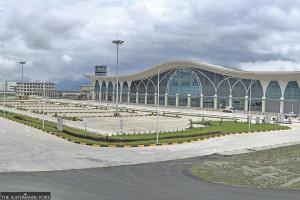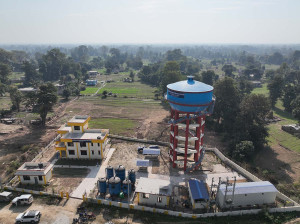Money
Gold imports soar fivefold amid turmoil
As investments stall and uncertainty deepens, Nepalis flock to gold as a safe-haven asset.
Krishana Prasain
Amid a global surge in bullion prices, Nepal’s gold imports in the first four months of the current fiscal year soared more than fivefold compared to the same period last year, with analysts attributing the spike to deepening political uncertainty and a gloomy investment climate.
Market experts say the share market and real estate sector continue to underperform, leaving investors wary after years of scandals, corruption, and policy turbulence. As other avenues stall, many are turning to gold as a safe-haven asset despite its historically high prices.
Gold was traded at Rs247,900 per tola on Tuesday.
Nepal’s sluggish investment environment is underscored by the banking sector’s loanable fund surplus, which has reached over Rs1 trillion—equivalent to 17 percent of GDP. At the same time, the country’s gross foreign exchange reserves climbed to Rs2.97 trillion, or $21.21 billion, by mid-October, sufficient to cover 16.4 months of imports, up from Rs2.67 trillion in mid-July.
The surge in demand has sharply pushed up imports.
Nepal bought 935 kg of gold worth Rs16.23 billion between mid-July and mid-November, according to the Department of Customs. Silver imports also jumped by 537.48 percent over the same period.
Traders say much of the gold and silver demand came in the form of coins and pure wire rings (beruwa aunthi), prized for their guaranteed resale value.
Gold, which is typically negatively correlated with the broader economy, tends to appreciate during periods of political and economic stress. “A safe-haven asset retains or gains value during turmoil. With the economy in a downturn, demand for gold naturally strengthens,” Anil Sharma, chief executive officer of the Nepal Bankers’ Association, said.
Responding to rising demand, Nepal Rastra Bank in October increased the daily gold import quota to 25 kg from 20 kg.
Sharma said banks import gold and silver based on market demand while keeping track of stock levels and weekly sales.
“Banks currently have 173 kg of gold in stock as of last Friday. As there is sufficient stock, we are not importing at the moment. Once this stock is absorbed by the market, imports will resume,” he said.
Bank stock had stood at 250 kg the previous week.
Bullion traders, however, offer a different view.
“People invested heavily as prices surged in the international market and expectations grew that gold could reach Rs500,000 per tola and silver Rs5,000. That prospect alone has driven demand,” said Diyesh Ratna Shakya, senior vice president of the Federation of Nepal Gold and Silver Dealers Association.
The yellow metal was Rs75,000 per tola before the Covid pandemic. On August 7, 2020, the price reached a high of Rs103,500, crossing the six-digit mark in the domestic market for the first time due to the Covid uncertainty.
Then it dropped to Rs80,000 per tola in 2021. Soon gold price started rising again, reaching over Rs100,000 per tola in January 2023.
International forecasts have contributed to the bullish sentiment. Bank of America now expects gold to average $4,538 per ounce in 2026, with a possible climb to $5,000 per ounce, driven by macroeconomic tailwinds and sustained safe-haven buying.
Traders say gold demand averaged around 45 kg per day during September and October but has begun easing gradually.
Still, they argue that with liquidity at a peak, deposits stagnant, and alternative investment sectors such as equities and real estate faltering, the government should consider allowing regulated investment in gold.
Under Nepal’s current rules, individuals cannot buy raw or bar gold from the central bank, commercial banks, or bullion traders. Nepal Rastra Bank authorises banks to import up to 25 kg per day, while traders may purchase only one kilogram at a time from banks.
Only registered bullion traders with a Permanent Account Number (PAN) are permitted to buy from banks, and retailers are allowed to sell jewellery but not bars. Despite the metal’s cultural and economic importance, Nepal still lacks clear regulations on gold jewellery holdings or taxation.
In the international market, gold continued its record-breaking run on Tuesday as expectations of a US Federal Reserve rate cut in December strengthened.
Global bullion prices hovered around $4,175 per ounce, extending Monday’s 2 percent jump and pushing the metal deeper into a multi-month rally fuelled by macro uncertainty, weaker yields, and strong safe-haven demand.




 19.12°C Kathmandu
19.12°C Kathmandu















